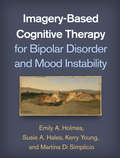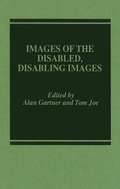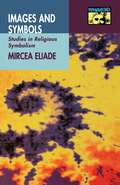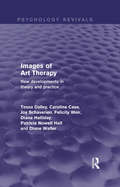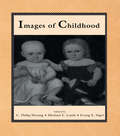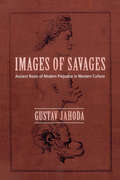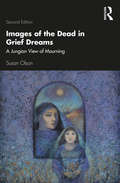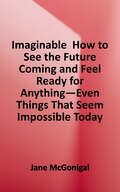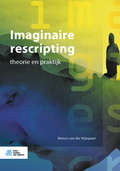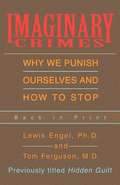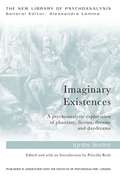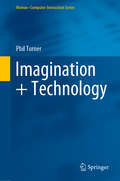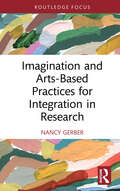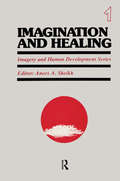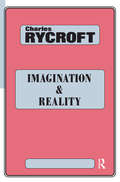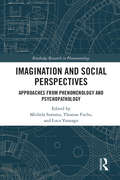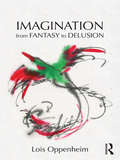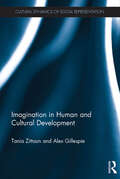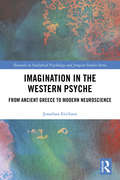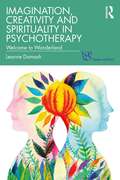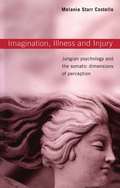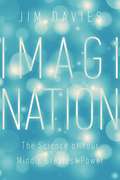- Table View
- List View
Imagery-Based Cognitive Therapy for Bipolar Disorder and Mood Instability
by Kerry Young Emily A. Holmes Susie A. Hales Martina Di SimplicioPeople with bipolar disorder are particularly vulnerable to anxiety and intrusive mental imagery, which can contribute to mood swings and a heightened risk for relapse. This book presents a novel brief treatment that focuses on working with mental images to reduce distress and enhance mood stability. Grounded in cognitive-behavioral therapy (CBT), the book provides therapists with tested techniques for formulating individualized treatment targets, using metacognitive strategies to reduce the power of images, rescripting problematic images, and building adaptive positive images. User-friendly instructions for assessment and intervention include case examples, sample scripts, and troubleshooting tips. In a large-size format for easy photocopying, the book includes 19 reproducible handouts and session agendas. Purchasers get access to a Web page where they can download and print the reproducible materials.
Images Of The Disabled, Disabling Images
by Alan Gartner Tom JoeThe first book of its kind, Images of the Disabled/Disabling Images combines an examination of the presentation of persons with disabilities in literature, film, and the media with an analysis of the ways in which these images are expressed in public policy concerning the disabled. <P><P> Leaders of the disability rights movement and major scholars of disability issues explore both attitudes toward the disabled, as well as the ways in which the disabling images of these attitudes are incorporated in employment, health, housing, and education policies. <P><P>Discussions include the appeal of new technological aids and new developments in community living. The first book of its kind, Images of the Disabled/Disabling Images combines an examination of the presentation of persons with disabilities in literature, film, and the media with an analysis of the ways in which these images are expressed in public policy concerning the disabled. Leaders of the disability rights movement and major scholars of disability issues explore both attitudes toward the disabled, as well as the ways in which the disabling images of these attitudes are incorporated in employment, health, housing, and education policies. Discussions include the appeal of new technological aids and new developments in community living.
Images and Symbols: Studies in Religious Symbolism (Bollingen Series #684)
by Mircea EliadeMircea Eliade--one of the most renowned expositors of the psychology of religion, mythology, and magic--shows that myth and symbol constitute a mode of thought that not only came before that of discursive and logical reasoning, but is still an essential function of human consciousness. He describes and analyzes some of the most powerful and ubiquitous symbols that have ruled the mythological thinking of East and West in many times and at many levels of cultural development.
Images of Art Therapy: New Developments in Theory and Practice (Psychology Revivals)
by Tessa Dalley Caroline Case Joy Schaverien Diane Waller Felicity Weir Diana Halliday Patsy Nowell HallWorking through the process of image-making in a therapeutic relationship, the art therapist is able to explore feelings, fantasies, and myths in different setting with diverse client groups. Originally published in 1987 Images of Art Therapy is a collection of essays by experienced art therapists which discuss and develop both theoretical and practical issues central to art therapy. The authors describe how they work through the use of illustrated case material which includes children, adolescents, and adults, in normal schools, psychiatric hospitals, therapeutic communities, and out-patient clinics. Theoretical considerations include bereavement, play, transference, symbolism, and verbal versus non-verbal communication. The first book on art therapy, Art as Therapy, edited by Tessa Dalley, was a useful introduction to the subject. Images of Art Therapy expands the issues raised in the earlier book in more depth, and develops new and innovative ideas which it was hoped, at the time, would influence both the theory and practice of art therapy in the future.
Images of Childhood
by Michael E. Lamb Irving E. Sigel C. Philip HwangThe twentieth century will surely be remembered as a period of remarkable calamity, vigorous intellectual activity, and striking technological progress. For the first time in history, the development of rapid forms of communication and transportation shrunk the effective size of the world so that many of its citizens were made aware of events occurring in far-distant locations and came to appreciate cultural differences more directly than was previously possible. Among the many trends and events for which the century may be remembered, however, one will surely be the ascendancy of science and scientific thinking. Given adequate resources and ample time, scientists have argued they will be able to reduce the mysteries of the universe, as well as the mysteries of life and death, to objectifiable processes and events. The editors of this book draw attention to the implicit and explicit images of childhood that various disciplines -- especially development psychology -- have constructed. These sometimes unspoken metaphors have enduring value in that they provide a means of drawing together, integrating, and interpreting otherwise disparate findings or conclusions. They also provide a ready means of conveying the fruits of scientific research to the people who constitute its primary consumers. The contributors strive to show that the images of childhood that each professional implicitly carries in her or his head vary across historical epochs, just as they vary across cultures and subcultures. Perhaps even more alarmingly, some of these images seem to reflect the politically correct ideology of particular times and places, at least as much as they represent the objective findings they purport to summarize. This volume's main objective is to unpackage cultural and historical variations in the conception of childhood in order to make clearer those which might be considered universal aspects of behavioral and psychological development and those which must be seen as temporary cultural constructions or images. The specific aims of this volume are to: * delineate images of childhood in diverse cultural, subcultural, and historical contexts; * illustrate how these images of childhood are manifested in popular proverbs as well as in distinct patterns of childrearing, broadly conceived to include aspects of parental behavior, childcare arrangements, education, indoctrination, and the assignment of responsibilities; * indicate how these images of childhood are manifest in the development and implementation of educational and social policies as well as in the legal status of children; * consider whether children are believed to have a privileged place in society and whether age-graded constraints limit their roles and participation in society; and * evaluate the extent to which cultural images affect the ways in which developmental processes are viewed or understood.
Images of Savages: Ancient Roots of Modern Prejudice in Western Culture
by Gustav JahodaIn Images of Savages, the distinguished psychologist Gustav Jahoda advances the provocative thesis that racism and the perpetual alienation of a racialized 'other' are a central leagacy of the Western tradition. Finding the roots of these demonizations deep in the myth and traditions of classical antiquity, he examines how the monstrous humanoid creatures of ancient myth and the fabulous "wild men" of the medieval European woods shaped early modern explorers' interpretations of the New World they encountered. Drawing on a global scale the schematic of the Western imagination of its "others," Jahoda locates the persistent identification of the racialized other with cannibalism, sexual abandon and animal drives. Turning to Europe's scientific tradition, Jahoda traces this imagery through the work of 18th century scientists on the relationship between humans and apes, the new racist biology of the 19th century studies of "savagery" as an arrested evolutionary state, and the assignment, especially of blacks, to a status intermediate between humans and animals, or that of children in need of paternal protection from Western masters. Finding in these traditional tropes a central influence upon the most current psychological theory, Jahoda presents a startling historical continuity of racial figuration that persists right up to the present day. Far from suggesting a program for the eradication of racial stereotypes, this remarkable effort nevertheless isolates the most significant barriers to equality buried deep within the Western tradition, and proposes a potentially redemptive self-awareness that will contribute to the gradual dismantling of racial injustice and alienation. Gustav Jahoda demonstrates how deeply rooted Western perceptions going back more than a thousand years are still feeding racial prejudice today. This highly original socio-historical contextualisation will be invaluable to scholars of psychology, sociology and anthropology, and to all those interested in the sources of racial prejudice.
Images of the Dead in Grief Dreams: A Jungian View of Mourning
by Susan OlsonWhile in training at the C.G. Jung Institute in Zürich in 1988, Susan Olson suffered the loss of her daughter in an auto accident. In this intimate and unique exploration, Olson uses C. G. Jung’s psychological framework to describe her journey through tragedy, guided by a series of vivid dreams. In Images of the Dead in Grief Dreams: A Jungian View of Mourning, Jung's definition of the dream as a "harbinger of fate, a portent and comforter, a messenger of the gods" evolves from theory into embodied insight as Olson describes her encounter with the transforming power of grief. Drawing from personal experience as well as theoretical and clinical material, Olson presents premonitory dreams, which occur before the loss of a loved one, and grief dreams, which follow a loved one’s death, and analyzes both according to Jung’s method of dream interpretation. Sharing her own dreams as well as those of other mourners, Olson asserts that such dreams play a crucial role in the dreamer’s emotional recovery and psychological development, otherwise known as the process of individuation. She sensitively offers an assessment of the stages of grief and draws on the Greek myth of Demeter and Persephone, Jung’s memoirs, and other literature to amplify her experience of mourning. In this rare combination of grief theory and dream work, Images of the Dead in Grief Dreams is both a grief memoir and an extensive study of C. G. Jung’s view of the mourning process. This fully updated revised edition will be of immense interest to Jungian analysts and trainees, academics, psychologists, students of Jungian dream analysis, and to all who have suffered loss.
Images of the Disabled, Disabling Images
by Alan Gartner Tom JoeIn this collection of a dozen essays, writers with strong backgrounds in the disability rights movement examine the roots of public attitudes toward the disabled. Several essays consider portrayals of people with disabilities in literature, film, and journalism. Others explore social policy toward the disabled in education, employment, and health-care. Nat Hentoff's powerful piece, ""The Awful Privacy of Baby Doe," expresses the author's outrage over the case of a child born with spina bifida who was denied treatment because doctors persuaded her parents that she would be better off dead.
Imaginable: How to See the Future Coming and Feel Ready for Anything--Even Things That Seem Impossible Today
by Jane McGonigalWorld-renowned future forecaster, game designer, and NEW YORK TIMES bestselling author Jane McGonigal gives us the tool s to imagine the future without fear. An accessible, optimistic field guide to the future. --San Francisco Chronicle "Reading this book is like sitting down with a creative, optimistic friend--and getting up as a new version of yourself.""--Daniel H. Pink, New York Times bestselling author of When The COVID-19 pandemic, increasingly frequent climate disasters, a new war -- events we might have called ""unimaginable"" or ""unthinkable"" in the past are now reality. Today it feels more challenging than ever to feel unafraid, hopeful, and equipped to face the future with optimism. How do we map out our lives when it seems impossible to predict what the world will be like next week, let alone next year or next decade? What we need now are strategies to help us recover our confidence and creativity in facing uncertain futures.In Imaginable, Jane McGonigal draws on the latest scientific research in psychology and neuroscience to show us how to train our minds to think the unthinkable and imagine the unimaginable. She invites us to play with the provocative thought experiments and future simulations she's designed exclusively for this book, with the goal to: - Build our collective imagination so that we can dive into the future and envision, in surprising detail, what our lives will look like ten years from now - Develop the courage and vision to solve problems creatively - Take actions and make decisions that will help shape the future we desire - Access "urgent optimism," an unstoppable force within each of us that activates our sense of agency Imaginable teaches us to be fearless, resilient, and bold in realizing a world with possibilities we cannot yet imagine--until reading this transformative, inspiring, and necessary book .
Imaginaire rescripting: theorie en praktijk
by Remco van der WijngaartDit boek biedt een praktische en volledige beschrijving van imaginaire rescripting als behandelmethode voor diverse klachten. Op overzichtelijke wijze wordt beschreven hoe de techniek toegepast kan worden in de behandeling van persoonlijkheidsproblematiek of als op zichzelf staande behandeling van angst- en stemmingsklachten. Daarnaast worden diverse specialistische toepassingsgebieden besproken zoals het gebruik van imaginaire rescripting bij nachtmerries, eetstoornissen dwangstoornis etc. Dit boek is een onmisbaar handboek voor therapeuten die deze techniek willen leren maar biedt door zijn volledigheid ook een mogelijkheid om reeds bestaande kennis en vaardigheden verder uit te breiden. Het boek beschrijft de verschillende fasen van de techniek. Beschreven wordt hoe een imaginatie-oefening kan worden gebruikt in de diagnostiekfase, hoe de therapeut beelden rescript tijdens de beginfase van de behandeling en hoe de cliënt leert zelf betekenisvolle beelden uit het verleden te herschrijven. Tenslotte wordt ook beschreven hoe imaginaire rescripting een methode kan zijn om de cliënt voor te bereiden op toekomstige triggersituaties. Iedere stap wordt toegelicht met overzichtelijke praktijkvoorbeelden. Daarnaast wordt ingegaan op diverse uitdagende situaties die clinici in de praktijk tegenkomen zoals cliënten die zeggen geen beelden te hebben, die worstelen met schuldgevoelens tijdens de rescripting, die zich kritisch uitlaten over de oefeningen en vele andere probleemsituaties. Remco van der Wijngaart is psychotherapeut en gezondheidszorgpsycholoog. Hij is meer dan 20 jaar werkzaam geweest op een academische afdeling van een ambulante geestelijke gezondheidszorginstelling waar hij opgeleid is in cognitieve gedragstherapie en schematherapie waarbij imaginaire rescripting een veelgebruikte interventie is. Momenteel is hij werkzaam in een zelfstandige praktijk voor psychotherapie.
Imaginal Love: The Meanings Of Imagination In Henry Corbin And James Hillman
by Tom CheethamCorbin's work on the role of imagination in the religions and its fundamental place in human life has had a lasting and wide-ranging influence on contemporary poetry and the humanities. Among his most influential readers were the poets Charles Olson and Robert Duncan and the archetypal psychologist James Hillman. Central to their common vision is the creative power of language, understood not as a human invention but as a fundamental feature of reality. This new book by philosopher, biologist, poet, and teacher Tom Cheetham provides an overview of Corbin's “psychocosmology” and its significance for Hillman's archetypal psychology, contemporary poetics, and spiritual practice. It will be of interest to psychotherapists, artists, poets, and anyone who has ever wondered at the mysterious power of language and the imagination to transform the human soul.
Imaginary Crimes: Why We Punish Ourselves and How to Stop
by Tom Ferguson Lewis EngelThis liberating book shows us how to break out of the self-defeating patterns that have been keeping us from attaining our most cherished goals.
Imaginary Existences: A psychoanalytic exploration of phantasy, fiction, dreams and daydreams (The New Library of Psychoanalysis)
by Ignes SodreImaginary Existences: A psychoanalytic exploration of phantasy, fiction, dreams and daydreams interweaves scholarly psychoanalytic knowledge and extensive clinical experience with insights derived from close readings of great literature in a uniquely imaginative and creative manner, convincingly demonstrating how these two ways of thinking – psychoanalysis and literary criticism – organically relate to each other. This is simultaneously a psychoanalytic book and a book about literature, illuminating the imaginative possibilities present within both the psychoanalytic encounter and the act of reading fiction. Scholarly and well researched, the psychoanalytic ideas presented have their basis in the work of Freud and Klein and some of their followers; the extensive and innovative writing about the great authors in Western literature is equally scholarly and lucent. Here, Ignês Sodré explores creativity itself and, specifically, the impediments to creative thinking: defences, mostly narcissistic, against dependency, guilt and loss, and the mis-use of imagination to deny reality. In her studies of the characters created by authors such as George Eliot, Cervantes, Flaubert, Thomas Mann, Proust and Shakespeare, Sodré examines the way great writers create characters who mis-use their imagination, twisting reality into romantic daydreams or sado-masochistic enactments, which petrify experience and freeze the fluidity of thought. Her clinical studies continue and expand this theme, broadening the field and lending verification and weight to the arguments. These two poles of Sodré’s thinking – psychoanalysis and literature – interact seamlessly in Imaginary Existences; the two disciplines work together, each an intimate part of a learned exploration of the human condition: our desires, our fears and our delusions. This convergence pays tribute to the great depth of the fictional work being studied and to the psychological validity of the psychoanalytic ideas. This book will be of interest to psychoanalysts, psychologists, psychotherapists, literary critics, and those interested in literature and literary criticism.
Imagination + Technology (Human–Computer Interaction Series)
by Phil TurnerImagination is highly valued and sought-after, yet elusive and ill-defined. Definitions range from narrowly cognitive accounts to those which endow imagination with world-making powers. Imagination underpins our ability to speculate about the future and to re-experience the past. The everyday functioning of society relies on being able to imagine the perspectives of others; and our sense of who we are depends on the stories our imaginations create. Our soaring imaginations have taken us to the moon and allowed Einstein to race a light beam. Unsurprisingly, imagination underlies every aspect of human-computer interaction, from the earliest conceptual sketches, through the realistic possibilities portrayed variously in well-known tools as scenarios and storyboards, through to the wilder shores of design fictions. Yet, curiously, imagination is very rarely addressed directly in the design and HCI literature (and is wholly missing from virtual reality). This book addresses this gap in our accounts of how we imagine, conceptualise, design and use digital technologies. Drawing on many years of practical and academic experience in human computer-interaction, together with a wide range of material from psychology, design, cognitive science and HCI, seasoned with a little philosophy and anthropology, Imagination + Technology first considers imagination itself and the principal farthings of a new account. Later chapters discuss the role of imagination in the design, aesthetics, use and experience of digital technologies before the concluding chapter focusses on the provocative nature of imagination. The book will be stimulating reading for anyone working in the field of interactive technology and related areas, whether academics, students or practitioners.
Imagination and Arts-Based Practices for Integration in Research
by Nancy GerberImagination and Arts-Based Practices for Integration in Research explores the philosophical assumptions, defining concepts, and methodological issues related to the introduction of intentional imaginative mental processes and arts-based practices into some or all phases of investigation, and data integration of particular research approaches. Although typically central to mixed, multi-method, and arts-based research, the practice of integrating diverse forms of data might be applied to other research traditions. The integration of data diversity represents a deviation from traditional scientific thinking demanding a dramatic paradigm shift inclusive of multi-dimensional, nondiscursive, aesthetic, rhizomatic, and imaginative mental processes. In this book, imaginative mental processes and arts-based practices are described and illustrated as approaches to investigating, revealing, and understanding the elusive yet essential meanings hidden in the crevices, shadows, and liminal spaces in between diverse data sets leading to integration, illumination, and synthesis. The book will appeal to arts-based, mixed methods, and adventurous researchers. It walks the reader through the revisionist philosophical assumptions and offers aligned methodological suggestions to the induction of imaginative mental processes and arts-based practices into research.
Imagination and Healing: Cultivating The Imagination For Healing, Change, And Growth (Imagery And Human Development Ser.)
by Anees A. SheikhThe volume explores in depth the vast healing potential of a fundamental human gift. In addition to providing a historical perspective of the importance accorded to imagination in the disease and healing processes, the book furnishes theoretical, empirical, and clinical evidence of the efficacy of imagery in the healing of a wide variety of health problems including stress, pain, cancer, depression, phobias, skin disorders, and sexual dysfunctions.
Imagination and Invention (Univocal)
by Gilbert SimondonA radical rethinking of the theory and the experience of mental images Here, in English translation for the first time, is Gilbert Simondon&’s fundamental reconception of the mental image and the theory of imagination and invention. Drawing on a vast range of mid-twentieth-century theoretical resources—from experimental psychology, cybernetics, and ethology to the phenomenological reflections of Sartre and Merleau-Ponty—Imagination and Invention provides a comprehensive account of the mental image and adds a vital new dimension to the theory of psychical individuation in Simondon&’s earlier, highly influential work.Simondon traces the development of the mental image through four phases: first a bundle of motor anticipations, the image becomes a cognitive system that mediates the organism&’s relation to its milieu, then a symbolic and abstract integration of motor and affective experience to, finally, invention, a solution to a problem of life that requires the externalization of the mental image and the creation of a technical object. An image cannot be understood from the perspective of one phase alone, he argues, but only within the trajectory of its progressive metamorphosis.
Imagination and Reality: Psychoanalytical Essays 1951-1961 (Maresfield Library)
by Charles RycroftA collection of essays, introduced by Masud Khan and J.D. Sutherland, on a variety of subjects including: observations on a case of vertigo; on idealization, illusion, and catastrophic disillusion; the nature and function of the analyst's communication to the patient; beyond the reality principle; and, the analysis of a detective story.
Imagination and Social Perspectives: Approaches from Phenomenology and Psychopathology (Routledge Research in Phenomenology)
by Thomas Fuchs Michela Summa Luca VanzagoOur experience of other individuals as minded beings goes hand in hand with the awareness that they have a unique epistemic and emotional perspective on the experienced objects and situations. The same object can be seen from many different points of view, an event can awaken different emotional reactions in different individuals, and our position-takings can in part be mediated by our belonging to some social or cultural groups. All these phenomena can be described by referring to the metaphor of perspective. Assuming that there are different, and irreducible, perspectives we can take on the experienced world, and on others as experiencing the same world, the phenomenon of mutual understanding can consistently be understood in terms of perspectival flexibility. This edited volume investigates the different processes in which perspectival flexibility occurs in social life and particularly focuses on the constitutive role of imagination in such processes. It includes original works in philosophy and psychopathology showing how perspectival flexibility and social cognition are grounded on the interplay of direct perception and imagination.
Imagination from Fantasy to Delusion (Psychoanalysis in a New Key Book Series)
by Lois OppenheimIn Imagination from Fantasy to Delusion, Lois Oppenheim illustrates the enhancement of self that creativity affords, the relationship of imagination to the self as agent. The premise of this book is twofold: First, that the imaginary is real. Where it differs from what we commonly take to be reality is in structure and in form. The imaginary of art, for example, is not illusionary for it is phenomenologically describable and even depictable, as demonstrated by the self-reflexive efforts of modernist painters and writers. No less real than the imaginary of art, and thus fantasy, is the imaginary of delusion, ascertainable in the very function it serves. Though fundamentally different, fantasy and delusion do share a significant feature: a preoccupation with agency. Second is that change, the enhancement of self through an increase in agency, is facilitated by the biology of reward: The pleasure of increased self-cohesion—the efficacy acquired through knowledge of, and the attribution of meaning to, the world—is ultimately the sine qua non of imaginative thought. Oppenheim emphasizes the idea that imagination generates knowledge. Our sensory systems, like our higher cognitive functions, give the human brain knowledge to maintain the homeostatic balance required for survival and to enrich the sense of self required for agency. And, she suggests, imagination is a function of their doing so. Moreover, she explores the construct by which we apprehend the workings of imagination—fantasy—and considers in what the mental imagery that endows it consists, how fantasy may be transmitted transgenerationally, and how delusion can be an impediment to imagination while also being a product of it. Additionally, she likens psychoanalysis to the making of art as a process of acquiring knowledge and looks at creativity itself as a coming-to-know. Throughout this book, there run several opposing threads. The first is that of the intra- and interpsychic psychoanalytic paradigms. This theoretical contrast bears on our understanding of aesthetic experience as sublimatory versus object relational and on our understanding of the construction of meaning. A second opposition resides in the notion of agency (with its implication of self-cohesion) which has everything to do with ego function and, seemingly, the usefulness of "unconscious fantasy," a cornerstone of psychoanalysis now thrown into question by the postmodern favoring of dissociation over repression and other mechanisms of defense. Last, but no less significant, is the contrast interwoven between the empiricism of neuroscience and the metaphysics of philosophical thought. Oppenheim's underlying effort is to explore the validity of these oppositions, which seem not to hold as steadfastly as we tend to suppose.
Imagination in Human and Cultural Development (Cultural Dynamics of Social Representation)
by Tania Zittoun Alex GillespieThis book positions imagination as a central concept which increases the understanding of daily life, personal life choices, and the way in which culture and society changes. Case studies from micro instances of reverie and daydreaming, to utopian projects, are included and analysed. The theoretical focus is on imagination as a force free from immediate constraints, forming the basis of our individual and collective agency. In each chapter, the authors review and integrate a wide range of classic and contemporary literature culminating in the proposal of a sociocultural model of imagination. The book takes into account the triggers of imagination, the content of imagination, and the outcomes of imagination. At the heart of the model is the interplay between the individual and culture; an exploration of how the imagination, as something very personal and subjective, grows out of our shared culture, and how our shared culture can be transformed by acts of imagination. Imagination in Human and Cultural Development offers new perspectives on the study of psychological learning, change, innovation and creativity throughout the lifespan. The book will appeal to academics and scholars in the fields of psychology and the social sciences, especially those with an interest in development, social change, cultural psychology, imagination and creativity.
Imagination in the Western Psyche: From Ancient Greece to Modern Neuroscience (Research in Analytical Psychology and Jungian Studies)
by Jonathan EricksonImagination in the Western Psyche: From Ancient Greece to Modern Neuroscience offers a comprehensive treatment of the human imagination by integrating the rich discourse on imagination in the humanities with modern neuroscientific research. This book is the first to offer an integrated understanding of imagination from both a humanistic (i.e., historical, philosophical, cultural, depth psychological) and scientific perspective. The book presents neurobiological accounts that align with prominent theories in Jungian and archetypal psychology and offers a window into the many ways imagination can be understood. It elaborates on the discourse on imagination in Western civilization that goes back thousands of years. Chapters analyze how imagination has been considered throughout history and contrasts a modern neuroscientific approach that looks at imagination by studying its component parts without addressing the phenomenon in all its experiential richness and complexity. By bringing these two approaches together an account of the human imagination emerges that is grounded in scientific rigor without diminishing the fullness of human experience. This book will appeal to academics, researchers, and post-graduate students in the fields of analytical psychology, depth psychology, Jungian studies, and psychotherapy
Imagination, Creativity and Spirituality in Psychotherapy: Welcome to Wonderland (Psyche and Soul)
by Leanne DomashThe aim of this book is to awaken creative desire and expand the imagination of the psychotherapist and, in turn, her patient. Each chapter is meant to surprise the reader and help him see the world in a new way. Many varieties of imagination are explored -- the spiritual, the relational, the dreamworld, the aesthetic and the adaptive. The author offers space to reflect, to daydream, to remember; space to pursue goals, to make new connections; space to take risks and space to be wrong. The psychotherapist is encouraged to find her own voice, be poetic, dare to create, converse with other disciplines and, most especially, enter the world of dreams. This is all passed onto the patient as the dyad enters the intersubjective field. Both scholarly and practical, this volume elegantly and persuasively synthesizes for the first time research in many fields, including spirituality and Kabbalah, neuroscience, the arts, biology and artificial intelligence, to give an in depth and original understanding of the current pressing problems in the rapidly changing field of psychotherapy: how do we work with unconscious processes and early memories to help our patients become more imaginative, creative, hopeful and resilient, and in so doing, heal. The relationship between the body and creative imagination is fully explored as well as the disruptive effect of trauma on the imagination and how to address this. The emphasis on surprise, uncanny communication, interdisciplinary inquiry, use of dreamwork and the imagination of the body — how it spontaneously meets new challenges— all stimulate the creativity of the reader. Through numerous case studies, the author illustrates the practical implications of how this exploration allows for deeper understanding and more effective treatment. With the innovative synthesis and specific techniques the author provides, the clinician has tools to carry on the work of moving the field of psychotherapy forward as well as work ever more effectively with patients.
Imagination, Illness and Injury: Jungian Psychology and the Somatic Dimensions of Perception
by Melanie Starr CostelloHow does the body influence the way we see the world? Imagination, Illness and Injury examines the psychological factors behind perceptual limitations and distortions and links a broad range of somatic manifestations with their resolution. Melanie Starr Costello applies Jungian theory to a variety of cases, attributing psychosomatic phenomena to cognitive processes that are common to us all. She analyses the role of illness in several life narratives, and interprets the appearance of somatic phenomena during important phases of analytic treatment. Together these case narratives present a significant challenge to established views of psychosomatics. Subjects covered include: archetypal constrictions of identity somatic elements of perception the psyche-soma split. Imagination, Illness and Injury brings a fresh perspective to the understanding and treatment of the psychotherapy client as a psycho-somatic unity. Jungian analysts, psychoanalysts, and psychotherapists will greatly benefit from the clinical applications of archetypal theory presented here.
Imagination: Understanding Our Mind's Greatest Power
by Jim DaviesThe first-ever book on the science of imagination, which sheds light on both the complex inner-workings of our mind and the ways in which we can channel imagination for a better life. We don’t think of imagination the way that we should. The word is often only associated with children, artists and daydreamers, viewed as something separate from everyday adult life. However, imagination is an integral part of almost every action and decision that we make. Simply put, imagination is a person’s ability to create scenarios in his or her head: this can include everything from planning a grocery list, to honing a golf swing, and even to having religious hallucinations. And while imagination has positive connotations, it can also lead to more pernicious outcomes including decreased productivity and cooperation, and much worse, the continuous reliving of past trauma. The human brain is remarkable in its ability to imagine—to create worlds and situations outside of its reality. We can imagine complex possible futures, fantasy worlds, and jars of peanut butter. We can use our imaginations to make us relaxed or anxious, and the most impressive feat of human imagination may be our ability to use it in creative endeavors. Sitting in a chair, with our eyes closed, we can imagine what the world might be, and construct elaborate plans. With such power, we have an obligation to use it for good—to make things better for ourselves, and for the world. People have been fascinated with the machination of the human brain and its ability to imagine for centuries, but until now, there have been no popular science books that are dedicated to imagination. There are books on creativity, dreams, memory, and the mind in general, but how exactly do we create those scenes in our head? With chapters ranging from hallucination and imaginary friends to how imagination can make you happier and more productive, Jim Davies' Imagination will help us explore the full potential of our own mind.
